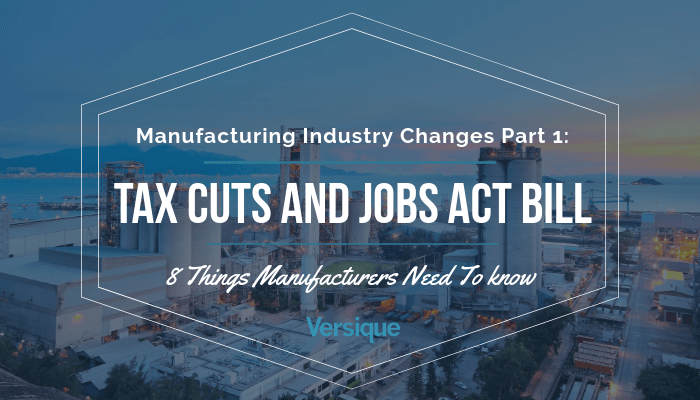
(Disclaimer: Consult with your tax advisor about your specifics issues and planning prior to filing. I am an executive search professional, and do not pretend to be a finance or accounting professional, definitely not tax.)
The manufacturing industry is no stranger to change. In recent years, the industry has seen a number of significant changes and trends brought upon by technology and automation. With new tax legislation and importation tariffs being imposed by the new administration, the manufacturing industry will need to brace for further changes.
To help manufacturers prepare for their new business environment, we wanted to create a 2-part guide to draw attention towards the high-level adjustments manufacturers should be aware of.
In Part 1, we’re going to look at the Tax Cuts and Jobs Act.
For manufacturers, the Tax Cuts and Jobs Act has the potential to impact business decisions that can improve the bottom line for 2018. However, it also features some less-than-positive changes that can affect your bottom line negatively. You won’t be filing your 2018 taxes for quite a while, but it always helps to be proactive when it comes to your business strategy.
What do manufacturers need to know of the Tax Cuts and Jobs Act?
1. Reduction of the Corporate Tax Rate
The corporate tax rate has been reduced from 35% to a flat 21% for corporations. The reduction should provide manufacturing corporations with a nice chunk of savings.
2. Repeal of Alternative Minimum Tax (AMT)
Corporations are able to offset their regular tax liability by AMT credit carryovers from prior years, potentially bringing their tax rate lower than 21%. The bill also repeals the election to accelerate AMT credits in lieu of bonus depreciation.
3. Research & Development Tax Deduction
For technical improvements done to improve the cost, efficiency, and environmental impact of a product, manufacturers can receive a tax deduction.
4. Limitations on Interest Expense
The deduction is limited to 30% of adjusted taxable income and applicable for manufacturing companies who have borrowed to finance equipment purchases. These restrictions could also impact business owners who lease real estate to their manufacturing companies.
5. Eliminate Carryback Net Operating Losses (NOLs)
This provision enforces new limits on NOLs and deductions for employee fringe benefits including repeals for deductions for some entertainment and recreation expenses. This change could present a cash flow obstacle.
6. Immediate Expensing of Capital Expenditures
Higher depreciation deductions for certain capital expenditures decrease taxable income, creating greater investment opportunities to modernize production processes and facilities. Updated to this bill, the equipment can be new or used.
7. Research & Experimentation Tax Deduction
Companies will be required to write-off research expenses over a longer time period, whereas before they had the option to take an immediate deduction.
8. Like-Kind Exchanges
Like-kind exchanges will be limited to exchanges of real property that is not primarily held for sale. With the new limitations being imposed, it’s vital that manufacturers consult their tax advisors before making like-kind exchanges.
In order to take advantage of some of the favorable changes to the tax law, as well as to brace for the adverse changes that could present issues for manufacturers, it’s important for companies to consult with their tax advisor to create a strategy.
Stay tuned for Part 2 of this series, where we will discuss how steel and aluminum tariffs will impact manufacturing.

